Business Law in a Digital Context
VerifiedAdded on 2023/05/26
|8
|1942
|441
AI Summary
This article discusses the importance of protecting intellectual property rights in the digital age and legal considerations for e-commerce in Europe. It explores the existing legal rights and possible legal problems related to intellectual property management, as well as the EU regulations and directives for transparent business practices.
Contribute Materials
Your contribution can guide someone’s learning journey. Share your
documents today.
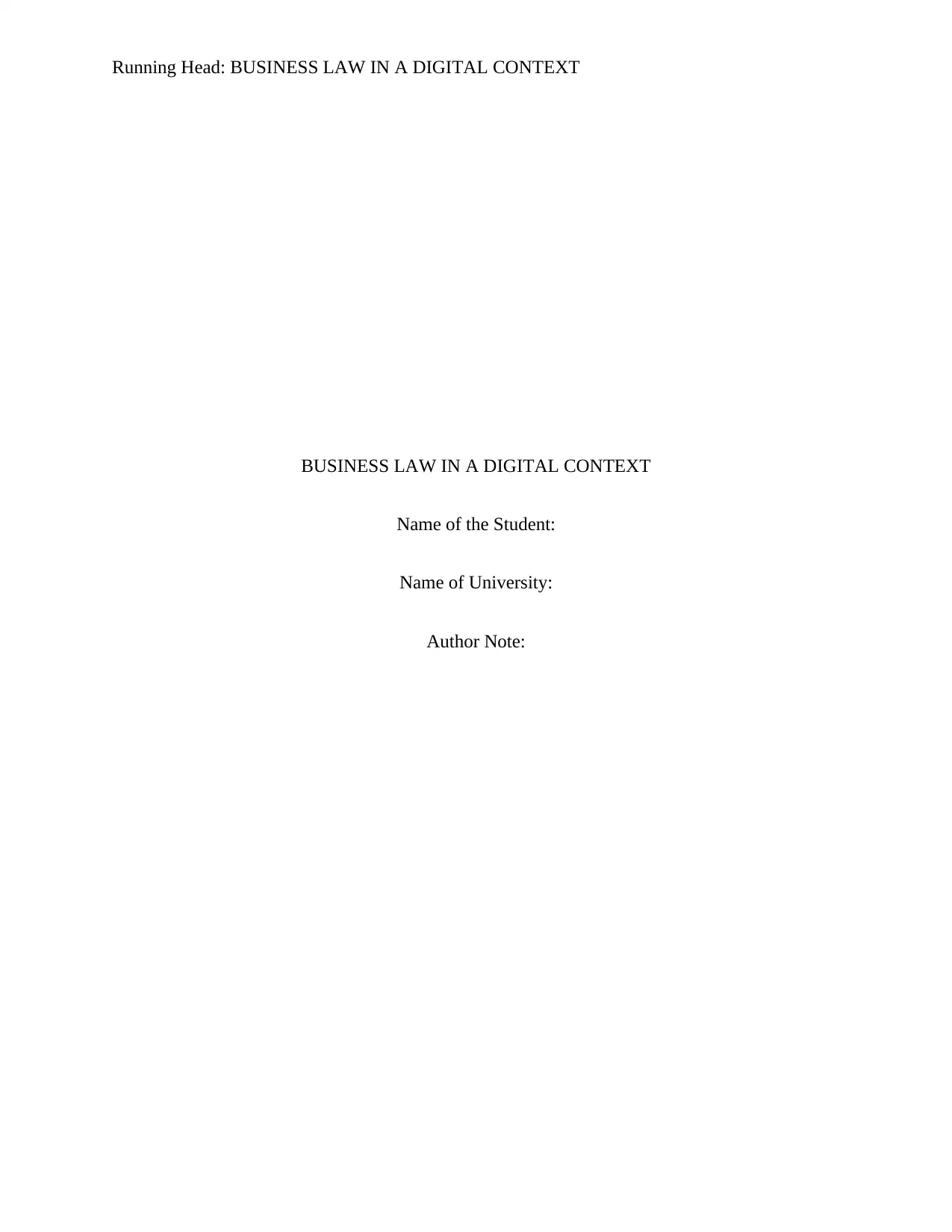
Running Head: BUSINESS LAW IN A DIGITAL CONTEXT
BUSINESS LAW IN A DIGITAL CONTEXT
Name of the Student:
Name of University:
Author Note:
BUSINESS LAW IN A DIGITAL CONTEXT
Name of the Student:
Name of University:
Author Note:
Secure Best Marks with AI Grader
Need help grading? Try our AI Grader for instant feedback on your assignments.
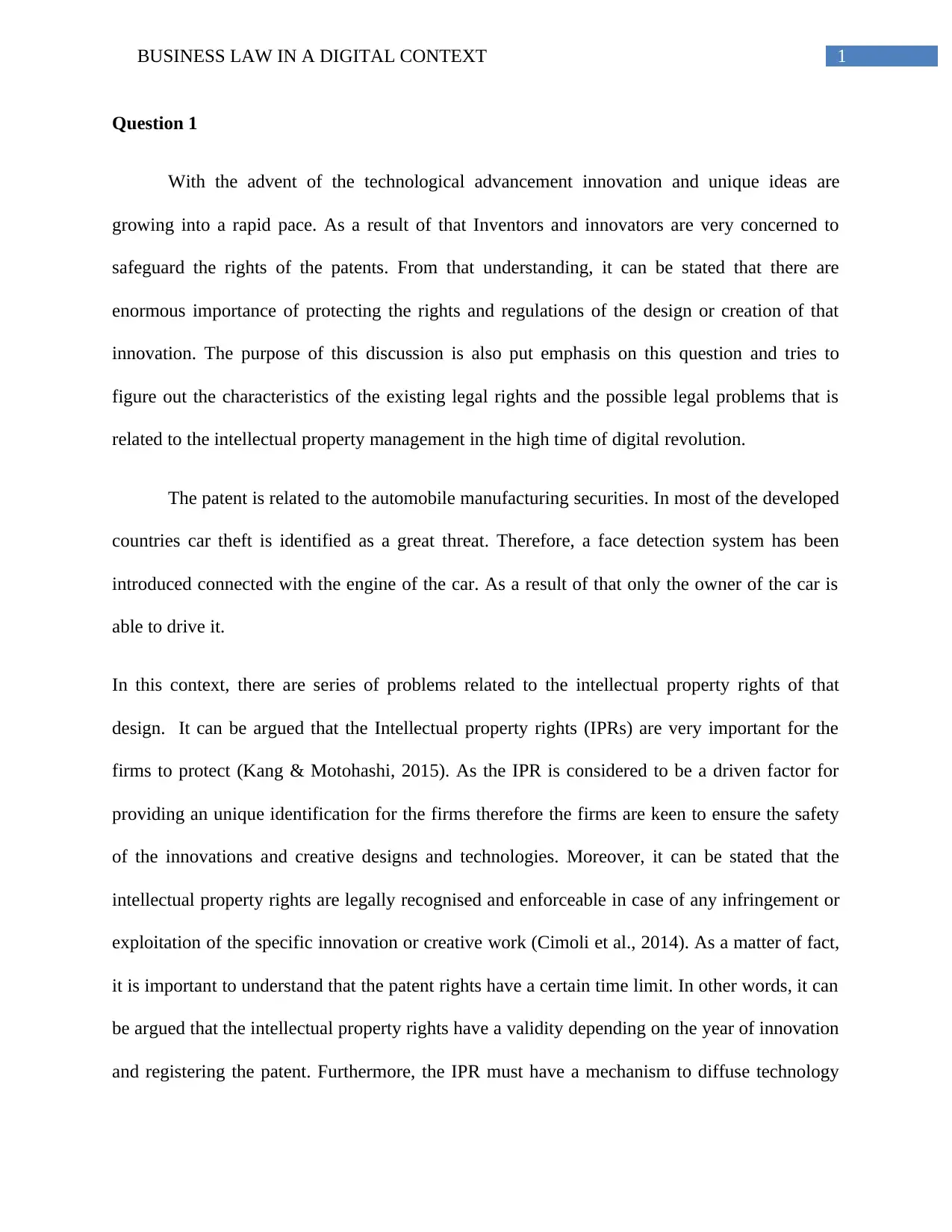
1BUSINESS LAW IN A DIGITAL CONTEXT
Question 1
With the advent of the technological advancement innovation and unique ideas are
growing into a rapid pace. As a result of that Inventors and innovators are very concerned to
safeguard the rights of the patents. From that understanding, it can be stated that there are
enormous importance of protecting the rights and regulations of the design or creation of that
innovation. The purpose of this discussion is also put emphasis on this question and tries to
figure out the characteristics of the existing legal rights and the possible legal problems that is
related to the intellectual property management in the high time of digital revolution.
The patent is related to the automobile manufacturing securities. In most of the developed
countries car theft is identified as a great threat. Therefore, a face detection system has been
introduced connected with the engine of the car. As a result of that only the owner of the car is
able to drive it.
In this context, there are series of problems related to the intellectual property rights of that
design. It can be argued that the Intellectual property rights (IPRs) are very important for the
firms to protect (Kang & Motohashi, 2015). As the IPR is considered to be a driven factor for
providing an unique identification for the firms therefore the firms are keen to ensure the safety
of the innovations and creative designs and technologies. Moreover, it can be stated that the
intellectual property rights are legally recognised and enforceable in case of any infringement or
exploitation of the specific innovation or creative work (Cimoli et al., 2014). As a matter of fact,
it is important to understand that the patent rights have a certain time limit. In other words, it can
be argued that the intellectual property rights have a validity depending on the year of innovation
and registering the patent. Furthermore, the IPR must have a mechanism to diffuse technology
Question 1
With the advent of the technological advancement innovation and unique ideas are
growing into a rapid pace. As a result of that Inventors and innovators are very concerned to
safeguard the rights of the patents. From that understanding, it can be stated that there are
enormous importance of protecting the rights and regulations of the design or creation of that
innovation. The purpose of this discussion is also put emphasis on this question and tries to
figure out the characteristics of the existing legal rights and the possible legal problems that is
related to the intellectual property management in the high time of digital revolution.
The patent is related to the automobile manufacturing securities. In most of the developed
countries car theft is identified as a great threat. Therefore, a face detection system has been
introduced connected with the engine of the car. As a result of that only the owner of the car is
able to drive it.
In this context, there are series of problems related to the intellectual property rights of that
design. It can be argued that the Intellectual property rights (IPRs) are very important for the
firms to protect (Kang & Motohashi, 2015). As the IPR is considered to be a driven factor for
providing an unique identification for the firms therefore the firms are keen to ensure the safety
of the innovations and creative designs and technologies. Moreover, it can be stated that the
intellectual property rights are legally recognised and enforceable in case of any infringement or
exploitation of the specific innovation or creative work (Cimoli et al., 2014). As a matter of fact,
it is important to understand that the patent rights have a certain time limit. In other words, it can
be argued that the intellectual property rights have a validity depending on the year of innovation
and registering the patent. Furthermore, the IPR must have a mechanism to diffuse technology
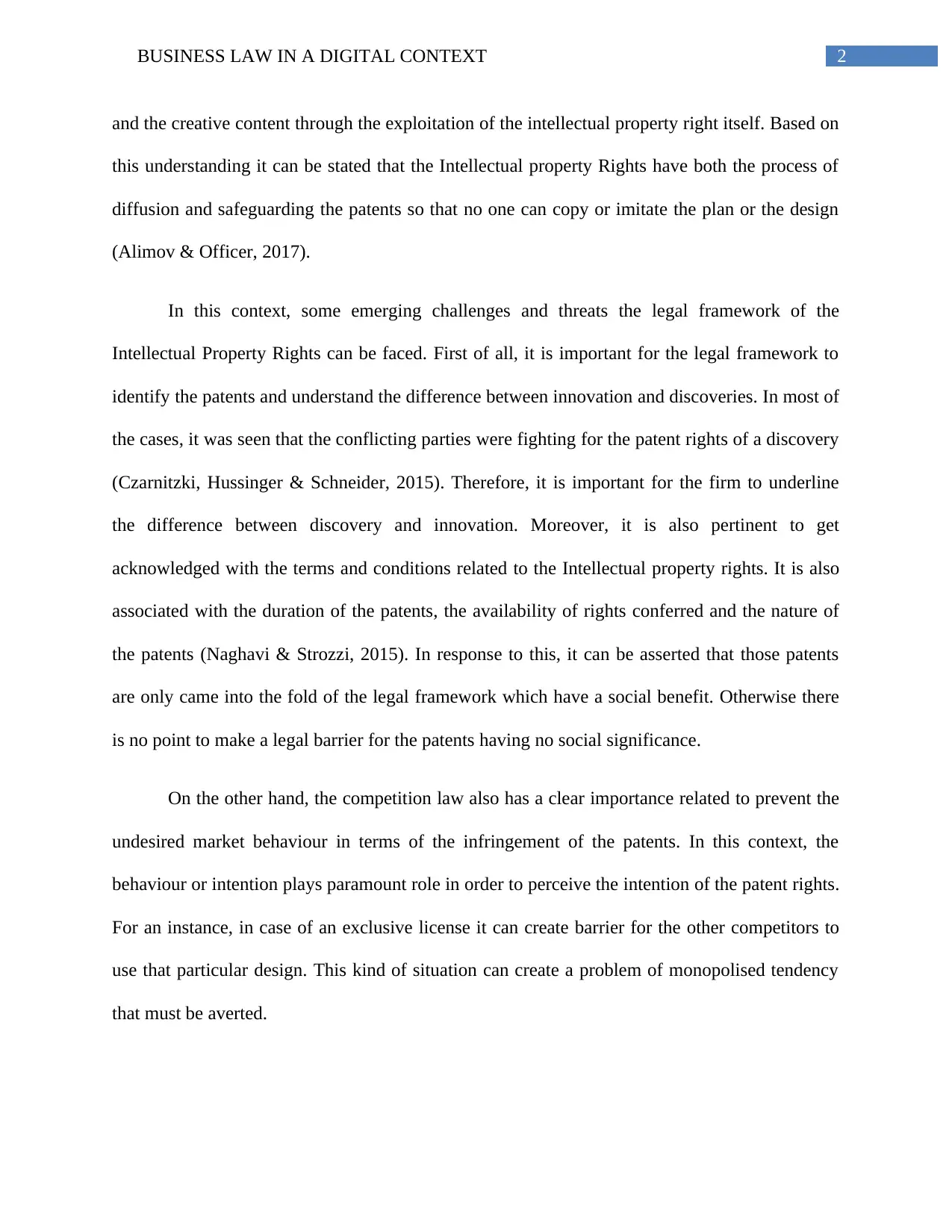
2BUSINESS LAW IN A DIGITAL CONTEXT
and the creative content through the exploitation of the intellectual property right itself. Based on
this understanding it can be stated that the Intellectual property Rights have both the process of
diffusion and safeguarding the patents so that no one can copy or imitate the plan or the design
(Alimov & Officer, 2017).
In this context, some emerging challenges and threats the legal framework of the
Intellectual Property Rights can be faced. First of all, it is important for the legal framework to
identify the patents and understand the difference between innovation and discoveries. In most of
the cases, it was seen that the conflicting parties were fighting for the patent rights of a discovery
(Czarnitzki, Hussinger & Schneider, 2015). Therefore, it is important for the firm to underline
the difference between discovery and innovation. Moreover, it is also pertinent to get
acknowledged with the terms and conditions related to the Intellectual property rights. It is also
associated with the duration of the patents, the availability of rights conferred and the nature of
the patents (Naghavi & Strozzi, 2015). In response to this, it can be asserted that those patents
are only came into the fold of the legal framework which have a social benefit. Otherwise there
is no point to make a legal barrier for the patents having no social significance.
On the other hand, the competition law also has a clear importance related to prevent the
undesired market behaviour in terms of the infringement of the patents. In this context, the
behaviour or intention plays paramount role in order to perceive the intention of the patent rights.
For an instance, in case of an exclusive license it can create barrier for the other competitors to
use that particular design. This kind of situation can create a problem of monopolised tendency
that must be averted.
and the creative content through the exploitation of the intellectual property right itself. Based on
this understanding it can be stated that the Intellectual property Rights have both the process of
diffusion and safeguarding the patents so that no one can copy or imitate the plan or the design
(Alimov & Officer, 2017).
In this context, some emerging challenges and threats the legal framework of the
Intellectual Property Rights can be faced. First of all, it is important for the legal framework to
identify the patents and understand the difference between innovation and discoveries. In most of
the cases, it was seen that the conflicting parties were fighting for the patent rights of a discovery
(Czarnitzki, Hussinger & Schneider, 2015). Therefore, it is important for the firm to underline
the difference between discovery and innovation. Moreover, it is also pertinent to get
acknowledged with the terms and conditions related to the Intellectual property rights. It is also
associated with the duration of the patents, the availability of rights conferred and the nature of
the patents (Naghavi & Strozzi, 2015). In response to this, it can be asserted that those patents
are only came into the fold of the legal framework which have a social benefit. Otherwise there
is no point to make a legal barrier for the patents having no social significance.
On the other hand, the competition law also has a clear importance related to prevent the
undesired market behaviour in terms of the infringement of the patents. In this context, the
behaviour or intention plays paramount role in order to perceive the intention of the patent rights.
For an instance, in case of an exclusive license it can create barrier for the other competitors to
use that particular design. This kind of situation can create a problem of monopolised tendency
that must be averted.
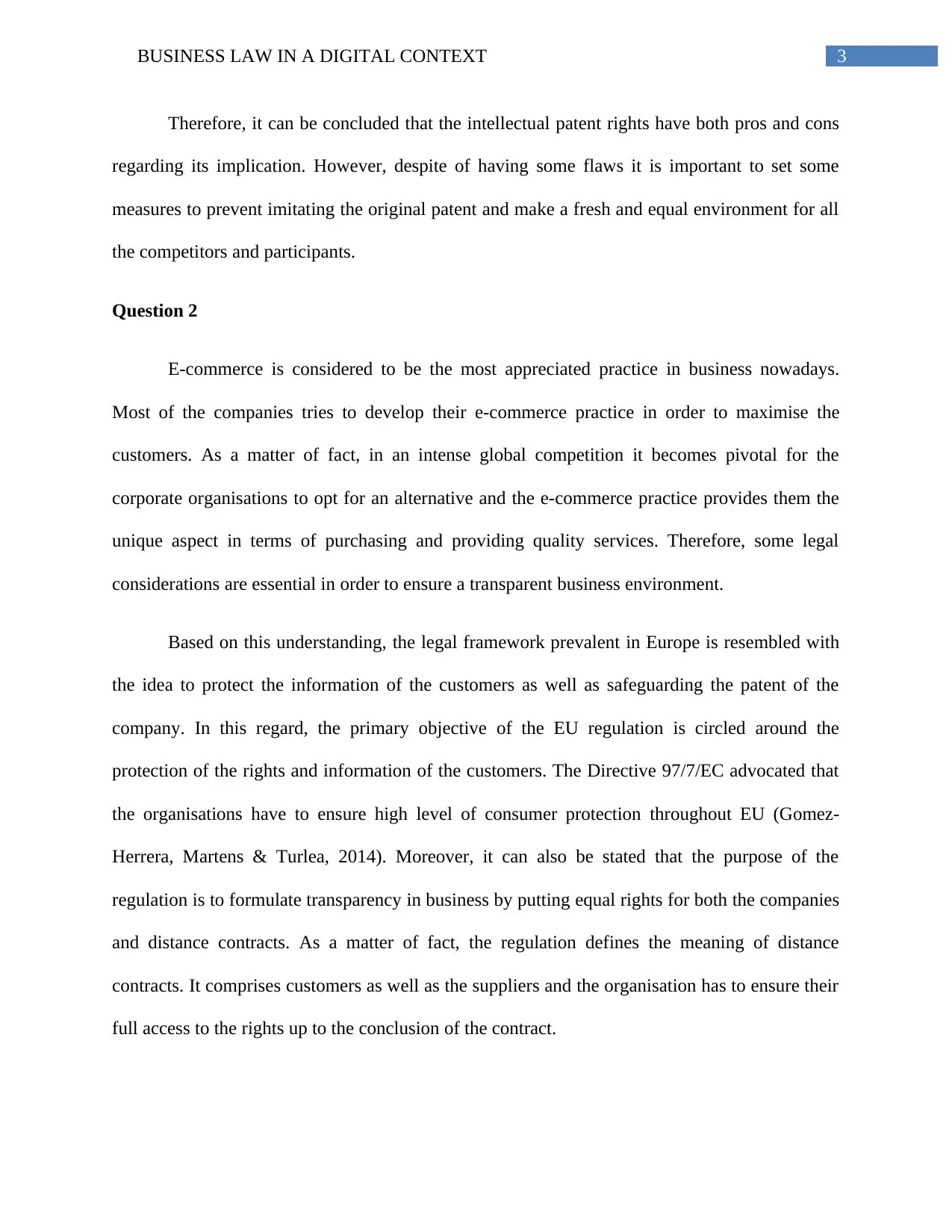
3BUSINESS LAW IN A DIGITAL CONTEXT
Therefore, it can be concluded that the intellectual patent rights have both pros and cons
regarding its implication. However, despite of having some flaws it is important to set some
measures to prevent imitating the original patent and make a fresh and equal environment for all
the competitors and participants.
Question 2
E-commerce is considered to be the most appreciated practice in business nowadays.
Most of the companies tries to develop their e-commerce practice in order to maximise the
customers. As a matter of fact, in an intense global competition it becomes pivotal for the
corporate organisations to opt for an alternative and the e-commerce practice provides them the
unique aspect in terms of purchasing and providing quality services. Therefore, some legal
considerations are essential in order to ensure a transparent business environment.
Based on this understanding, the legal framework prevalent in Europe is resembled with
the idea to protect the information of the customers as well as safeguarding the patent of the
company. In this regard, the primary objective of the EU regulation is circled around the
protection of the rights and information of the customers. The Directive 97/7/EC advocated that
the organisations have to ensure high level of consumer protection throughout EU (Gomez-
Herrera, Martens & Turlea, 2014). Moreover, it can also be stated that the purpose of the
regulation is to formulate transparency in business by putting equal rights for both the companies
and distance contracts. As a matter of fact, the regulation defines the meaning of distance
contracts. It comprises customers as well as the suppliers and the organisation has to ensure their
full access to the rights up to the conclusion of the contract.
Therefore, it can be concluded that the intellectual patent rights have both pros and cons
regarding its implication. However, despite of having some flaws it is important to set some
measures to prevent imitating the original patent and make a fresh and equal environment for all
the competitors and participants.
Question 2
E-commerce is considered to be the most appreciated practice in business nowadays.
Most of the companies tries to develop their e-commerce practice in order to maximise the
customers. As a matter of fact, in an intense global competition it becomes pivotal for the
corporate organisations to opt for an alternative and the e-commerce practice provides them the
unique aspect in terms of purchasing and providing quality services. Therefore, some legal
considerations are essential in order to ensure a transparent business environment.
Based on this understanding, the legal framework prevalent in Europe is resembled with
the idea to protect the information of the customers as well as safeguarding the patent of the
company. In this regard, the primary objective of the EU regulation is circled around the
protection of the rights and information of the customers. The Directive 97/7/EC advocated that
the organisations have to ensure high level of consumer protection throughout EU (Gomez-
Herrera, Martens & Turlea, 2014). Moreover, it can also be stated that the purpose of the
regulation is to formulate transparency in business by putting equal rights for both the companies
and distance contracts. As a matter of fact, the regulation defines the meaning of distance
contracts. It comprises customers as well as the suppliers and the organisation has to ensure their
full access to the rights up to the conclusion of the contract.
Secure Best Marks with AI Grader
Need help grading? Try our AI Grader for instant feedback on your assignments.
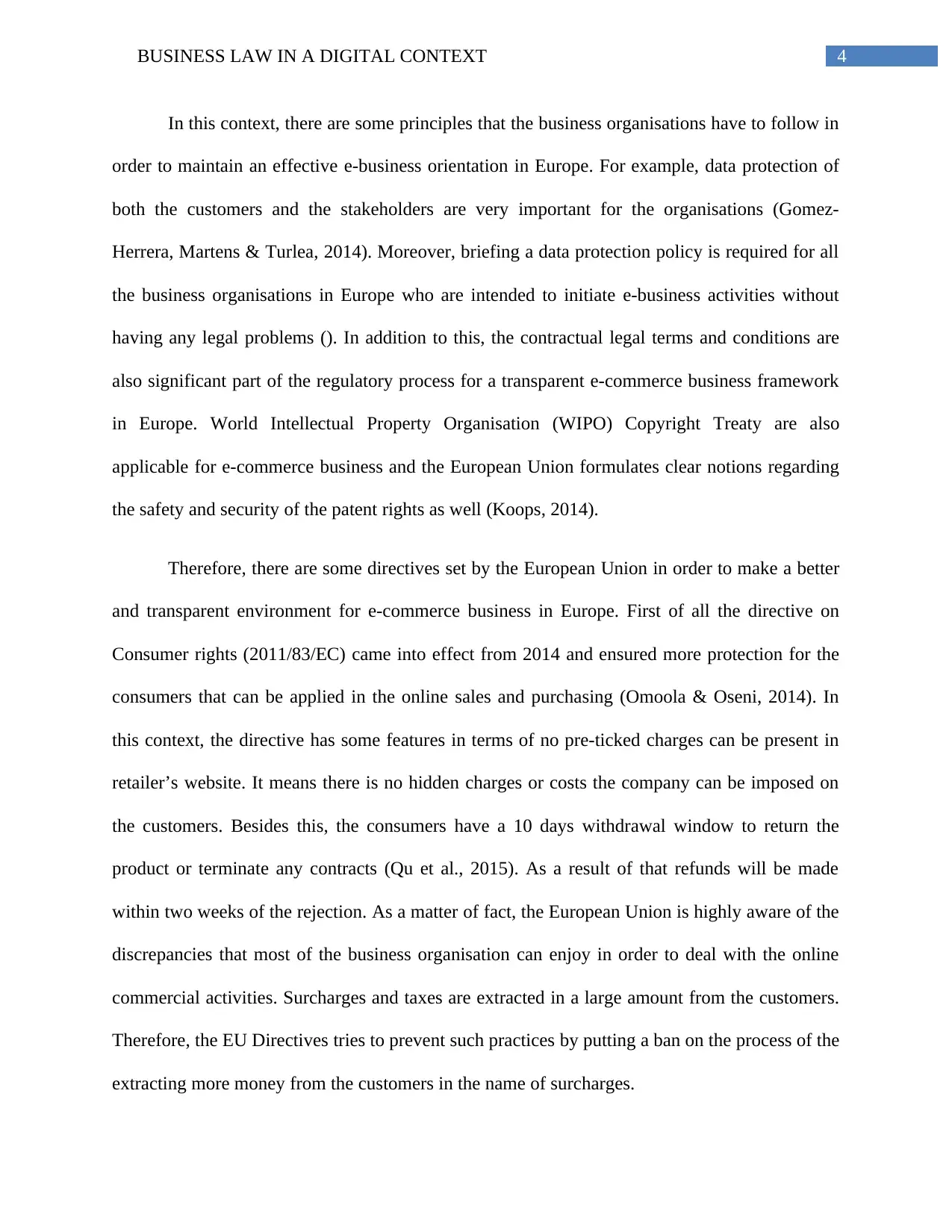
4BUSINESS LAW IN A DIGITAL CONTEXT
In this context, there are some principles that the business organisations have to follow in
order to maintain an effective e-business orientation in Europe. For example, data protection of
both the customers and the stakeholders are very important for the organisations (Gomez-
Herrera, Martens & Turlea, 2014). Moreover, briefing a data protection policy is required for all
the business organisations in Europe who are intended to initiate e-business activities without
having any legal problems (). In addition to this, the contractual legal terms and conditions are
also significant part of the regulatory process for a transparent e-commerce business framework
in Europe. World Intellectual Property Organisation (WIPO) Copyright Treaty are also
applicable for e-commerce business and the European Union formulates clear notions regarding
the safety and security of the patent rights as well (Koops, 2014).
Therefore, there are some directives set by the European Union in order to make a better
and transparent environment for e-commerce business in Europe. First of all the directive on
Consumer rights (2011/83/EC) came into effect from 2014 and ensured more protection for the
consumers that can be applied in the online sales and purchasing (Omoola & Oseni, 2014). In
this context, the directive has some features in terms of no pre-ticked charges can be present in
retailer’s website. It means there is no hidden charges or costs the company can be imposed on
the customers. Besides this, the consumers have a 10 days withdrawal window to return the
product or terminate any contracts (Qu et al., 2015). As a result of that refunds will be made
within two weeks of the rejection. As a matter of fact, the European Union is highly aware of the
discrepancies that most of the business organisation can enjoy in order to deal with the online
commercial activities. Surcharges and taxes are extracted in a large amount from the customers.
Therefore, the EU Directives tries to prevent such practices by putting a ban on the process of the
extracting more money from the customers in the name of surcharges.
In this context, there are some principles that the business organisations have to follow in
order to maintain an effective e-business orientation in Europe. For example, data protection of
both the customers and the stakeholders are very important for the organisations (Gomez-
Herrera, Martens & Turlea, 2014). Moreover, briefing a data protection policy is required for all
the business organisations in Europe who are intended to initiate e-business activities without
having any legal problems (). In addition to this, the contractual legal terms and conditions are
also significant part of the regulatory process for a transparent e-commerce business framework
in Europe. World Intellectual Property Organisation (WIPO) Copyright Treaty are also
applicable for e-commerce business and the European Union formulates clear notions regarding
the safety and security of the patent rights as well (Koops, 2014).
Therefore, there are some directives set by the European Union in order to make a better
and transparent environment for e-commerce business in Europe. First of all the directive on
Consumer rights (2011/83/EC) came into effect from 2014 and ensured more protection for the
consumers that can be applied in the online sales and purchasing (Omoola & Oseni, 2014). In
this context, the directive has some features in terms of no pre-ticked charges can be present in
retailer’s website. It means there is no hidden charges or costs the company can be imposed on
the customers. Besides this, the consumers have a 10 days withdrawal window to return the
product or terminate any contracts (Qu et al., 2015). As a result of that refunds will be made
within two weeks of the rejection. As a matter of fact, the European Union is highly aware of the
discrepancies that most of the business organisation can enjoy in order to deal with the online
commercial activities. Surcharges and taxes are extracted in a large amount from the customers.
Therefore, the EU Directives tries to prevent such practices by putting a ban on the process of the
extracting more money from the customers in the name of surcharges.
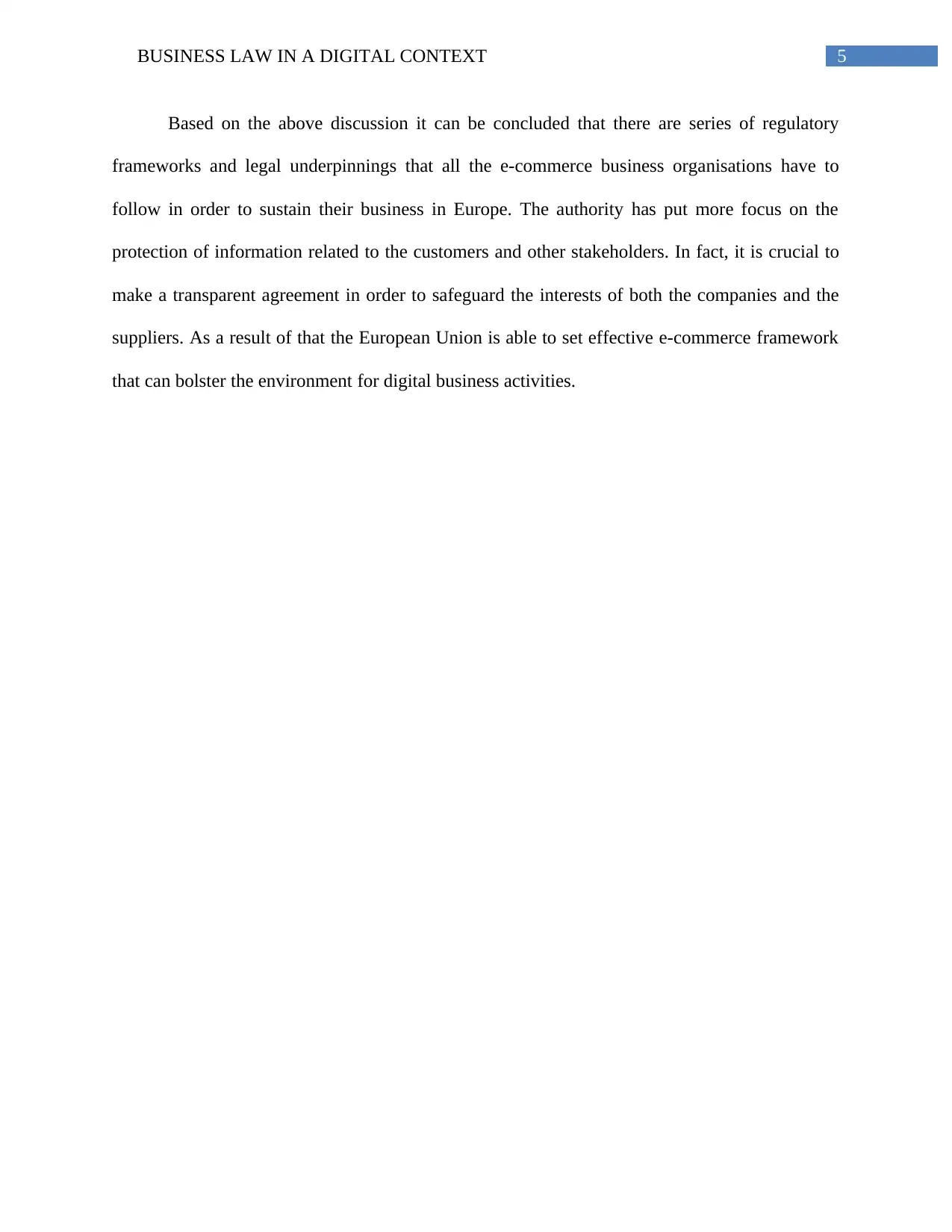
5BUSINESS LAW IN A DIGITAL CONTEXT
Based on the above discussion it can be concluded that there are series of regulatory
frameworks and legal underpinnings that all the e-commerce business organisations have to
follow in order to sustain their business in Europe. The authority has put more focus on the
protection of information related to the customers and other stakeholders. In fact, it is crucial to
make a transparent agreement in order to safeguard the interests of both the companies and the
suppliers. As a result of that the European Union is able to set effective e-commerce framework
that can bolster the environment for digital business activities.
Based on the above discussion it can be concluded that there are series of regulatory
frameworks and legal underpinnings that all the e-commerce business organisations have to
follow in order to sustain their business in Europe. The authority has put more focus on the
protection of information related to the customers and other stakeholders. In fact, it is crucial to
make a transparent agreement in order to safeguard the interests of both the companies and the
suppliers. As a result of that the European Union is able to set effective e-commerce framework
that can bolster the environment for digital business activities.
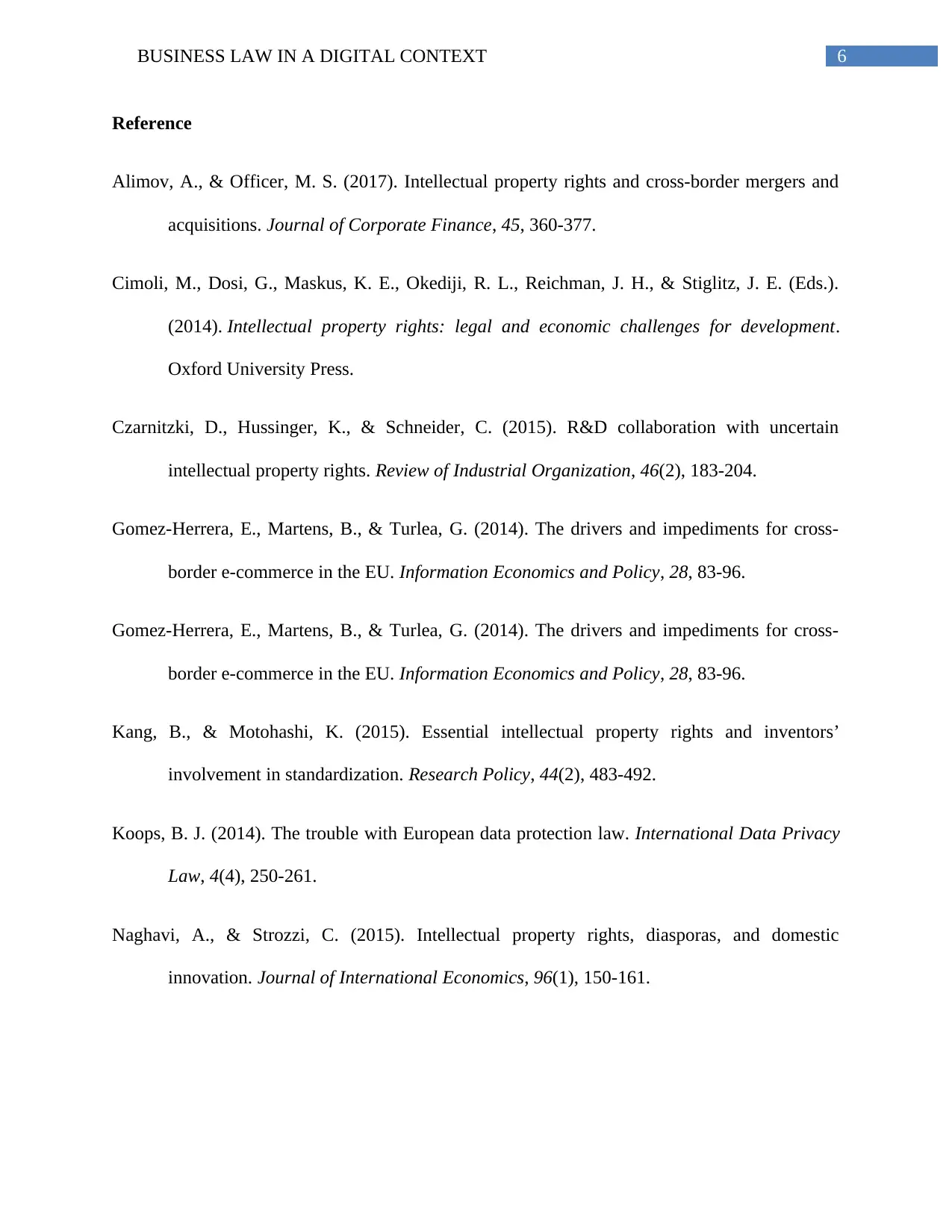
6BUSINESS LAW IN A DIGITAL CONTEXT
Reference
Alimov, A., & Officer, M. S. (2017). Intellectual property rights and cross-border mergers and
acquisitions. Journal of Corporate Finance, 45, 360-377.
Cimoli, M., Dosi, G., Maskus, K. E., Okediji, R. L., Reichman, J. H., & Stiglitz, J. E. (Eds.).
(2014). Intellectual property rights: legal and economic challenges for development.
Oxford University Press.
Czarnitzki, D., Hussinger, K., & Schneider, C. (2015). R&D collaboration with uncertain
intellectual property rights. Review of Industrial Organization, 46(2), 183-204.
Gomez-Herrera, E., Martens, B., & Turlea, G. (2014). The drivers and impediments for cross-
border e-commerce in the EU. Information Economics and Policy, 28, 83-96.
Gomez-Herrera, E., Martens, B., & Turlea, G. (2014). The drivers and impediments for cross-
border e-commerce in the EU. Information Economics and Policy, 28, 83-96.
Kang, B., & Motohashi, K. (2015). Essential intellectual property rights and inventors’
involvement in standardization. Research Policy, 44(2), 483-492.
Koops, B. J. (2014). The trouble with European data protection law. International Data Privacy
Law, 4(4), 250-261.
Naghavi, A., & Strozzi, C. (2015). Intellectual property rights, diasporas, and domestic
innovation. Journal of International Economics, 96(1), 150-161.
Reference
Alimov, A., & Officer, M. S. (2017). Intellectual property rights and cross-border mergers and
acquisitions. Journal of Corporate Finance, 45, 360-377.
Cimoli, M., Dosi, G., Maskus, K. E., Okediji, R. L., Reichman, J. H., & Stiglitz, J. E. (Eds.).
(2014). Intellectual property rights: legal and economic challenges for development.
Oxford University Press.
Czarnitzki, D., Hussinger, K., & Schneider, C. (2015). R&D collaboration with uncertain
intellectual property rights. Review of Industrial Organization, 46(2), 183-204.
Gomez-Herrera, E., Martens, B., & Turlea, G. (2014). The drivers and impediments for cross-
border e-commerce in the EU. Information Economics and Policy, 28, 83-96.
Gomez-Herrera, E., Martens, B., & Turlea, G. (2014). The drivers and impediments for cross-
border e-commerce in the EU. Information Economics and Policy, 28, 83-96.
Kang, B., & Motohashi, K. (2015). Essential intellectual property rights and inventors’
involvement in standardization. Research Policy, 44(2), 483-492.
Koops, B. J. (2014). The trouble with European data protection law. International Data Privacy
Law, 4(4), 250-261.
Naghavi, A., & Strozzi, C. (2015). Intellectual property rights, diasporas, and domestic
innovation. Journal of International Economics, 96(1), 150-161.
Paraphrase This Document
Need a fresh take? Get an instant paraphrase of this document with our AI Paraphraser
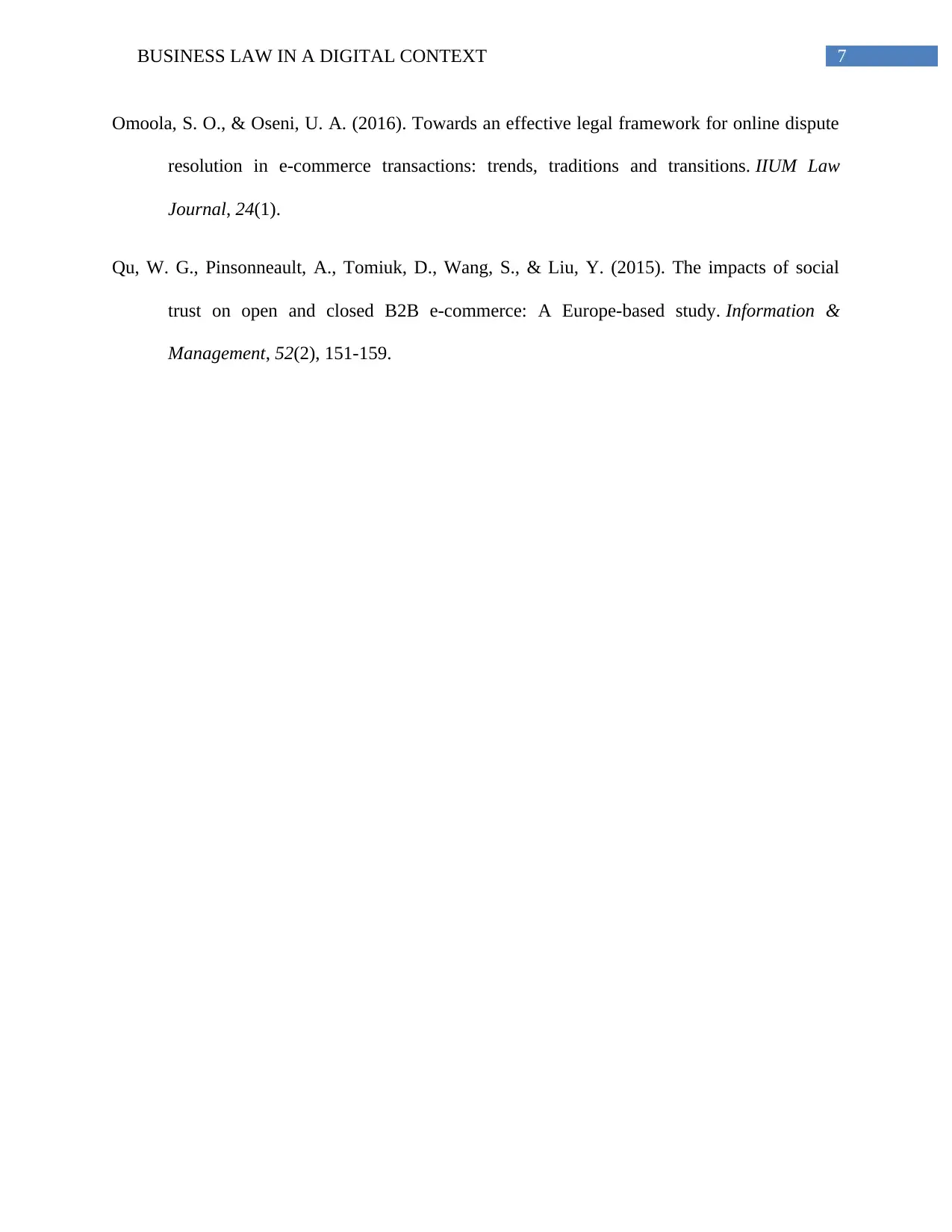
7BUSINESS LAW IN A DIGITAL CONTEXT
Omoola, S. O., & Oseni, U. A. (2016). Towards an effective legal framework for online dispute
resolution in e-commerce transactions: trends, traditions and transitions. IIUM Law
Journal, 24(1).
Qu, W. G., Pinsonneault, A., Tomiuk, D., Wang, S., & Liu, Y. (2015). The impacts of social
trust on open and closed B2B e-commerce: A Europe-based study. Information &
Management, 52(2), 151-159.
Omoola, S. O., & Oseni, U. A. (2016). Towards an effective legal framework for online dispute
resolution in e-commerce transactions: trends, traditions and transitions. IIUM Law
Journal, 24(1).
Qu, W. G., Pinsonneault, A., Tomiuk, D., Wang, S., & Liu, Y. (2015). The impacts of social
trust on open and closed B2B e-commerce: A Europe-based study. Information &
Management, 52(2), 151-159.
1 out of 8
Related Documents
Your All-in-One AI-Powered Toolkit for Academic Success.
+13062052269
info@desklib.com
Available 24*7 on WhatsApp / Email
![[object Object]](/_next/static/media/star-bottom.7253800d.svg)
Unlock your academic potential
© 2024 | Zucol Services PVT LTD | All rights reserved.




